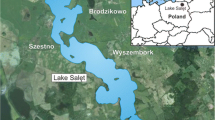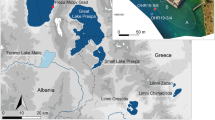Abstract
Pollen and plant macrofossils were analysed at Sägistalsee (1935 m asl), a small lake near timber-line in the Swiss Northern Alps. Open forests with Pinus cembra and Abies alba covered the catchment during the early Holocene (9000–6300 cal. BP), suggesting subcontinental climate conditions. After the expansion of Picea abies between 6300 and 6000 cal. BP the subalpine forest became denser and the tree-line reached its maximum elevation at around 2260 m asl. Charcoal fragments in the macrofossil record indicate the beginning of Late-Neolithic human impact at ca. 4400 cal. BP, followed by a extensive deforestation and lowering of the forest-limit in the catchment of Sägistalsee at 3700 cal. BP (Bronze Age). Continuous human activity, combined with a more oceanic climate during the later Holocene, led to the local extinction of Pinus cembra and Abies alba and favoured the mass expansion of Picea and Alnus viridis in the subalpine area of the Northern Alps. The periods before 6300 and after 3700 cal. BP are characterised by high erosion activity in the lake's catchment, whereas during the phase of dense Picea-Pinus cembra-Abies forests (6300–3700 cal. BP) soils were stable and sediment-accumulation rates in the lake were low. Due to decreasing land-use at higher altitudes during the Roman occupation and the Migration period, forests spread beween ca. 2000 and 1500 cal. BP, before human impact increased again in the early Middle Ages. Recent reforestation due to land-use changes in the 20th century is recorded in the top sediments. Pollen-inferred July temperature and annual precipitation suggest a trend to cooler and more oceanic climate starting at about 5500 cal. BP.
Similar content being viewed by others
References
Ammann B. and Wick L. 1993. Analysis of fossil stomata of conifers as indicators of the alpine tree line fluctuations during the Holocene. In Frenzel B. (ed.), Oscillations of the Alpine and Polar Tree Limits in the Holocene. Paläoklimaforschung 9. Gustav Fischer, Stuttgart/Jena/New York, pp. 175–186.
Ammann B., Gaillard M.-J. and Lotter A.F. 1996. Switzerland. In: Berglund B.E., Birks H.J.B., Ralska-Jasiewiczowa M. and Wright H.E. (eds), Palaeoecological Events During the Last 15,000 Years: Regional Syntheses of Palaeoecological Studies of Lakes and Mires in Europe. John Wiley and Sons, Chichester, pp. 647–666.
Bennett K.D. 1996. Determination of the number of zones in a biostratigraphical sequence. New Phytol. 132: 155–170.
Birks H.H. and Ammann B. 2000. Two terrestrial records of rapid climatic change during the glacial-Holocene transition (14,000-9000 calendar years B.P.) from Europe. Proc. Natl. Acad. Sci. USA 97: 1390–1394.
Birks H.H. and Birks H.J.B. 2000. Future uses of pollen analysis must include macrofossils. J. Biogeogr. 27: 31–35.
Birks H. J. B. 1995. Quantitative palaeoenvironmental reconstructions. In Maddy D. and Brew J.S. (eds), Statistical Modelling of Quaternary Science Data. Quaternary Research Association, Cambridge, pp. 161–254.
Birks H.J.B. and Gordon A.D. 1985. Numerical Methods in Quaternary Pollen Analysis. Academic Press, London, 317 pp.
Burga C.A. 1988. Swiss vegetation history during the last 18,000 years. New Phytol. 110: 581–602.
Burga C.A. and Perret R. 1998. Vegetation and Climate History in Switzerland During the Later Pleistocene and Holocene. Ott, Thun, 805 pp.
Fedele F.G. and Wick L. 1996. Glacial/Postglacial transition south of Splügenpass: environment and human activity. Il Quaternario 9: 541–550.
Dansgaard W., Johnson S.J., Clausen H.B., Dahl-Jensen D., Gundestrup N.S., Hammer C.U., Hvidberg C.S., Steffensen J.P., Sveinbjörnsdottir A.E., Jouzel J. and Bond G. 1993. Evidence for general instability of past climate from a 250-kyr ice-record. Nature 364: 218–220.
Grootes P.M., Stuiver M., White J.W.C., Johnson S. and Jouzel J. 1993. Comparison of oxygen isotope records from the GISP2 and GRIP Greenland ice cores. Nature 366: 552–554.
Haas J.N., Richoz I., Tinner W. and Wick L. 1998. ynchrononous Holocene climatic oscillations recorded on the Swiss Plateau and at timberline in the Alps. The Holocene 8: 301–309.
Heiri O. and Lotter A.F. 2003. 9000 years of chironomid assemblage dynamics in an Alpine lake: long-term trends, sensitivity to disturbance and resilience of the fauna. J. Paleolim. 30: 273–289
Heiri O., Wick L., van Leeuwen J.F.N., van der Knaap W.O. and Lotter A.F. 2003. Holocene tree immigration and the chironomid fauna of a small Swiss subalpine lake (Hinterburgsee, 1515 m asl). Palaeogeogr. Palaeoclim. Palaeoecol. 189: 35–53.
Hirt A.M., Lanci L. and Koinig K.A. 2003. Mineral magnetic record of Holocene environmental changes in Sägistalsee, Switzerland. J. Paleolim. 30: 321–331.
Koinig K.A., Shotyk W., Lotter A.F., Ohlendorf C. and Sturm M. 2003. 9000 years of geochemical evolution of lithogenic major and trace elements in the sediments of an alpine lake — the role of climate, vegetation and land use history. J. Paleolim. 30: 307–320.
Kuoch R. 1954. Wälder der Schweizer Alpen im Verbreitungsgebiet der Weisstanne. Eidg. Anst. Forstl. Versuchswesen 30: 133–260.
Kral F. and Mayer H. 1993. Postglaziale Entstehung und Aufbau tannenreicher Wälder Europas. In: Brombacher C., Jacomet S and Haas J.N. (eds), Festschrift Zoller. Diss. Bot. 196: 305–316.
Kutzbach J. E. and Street-Perrott F.A. 1985. Milankovitch forcing of fluctuations in the level of tropical lakes from 18 to 0 kyr BP. Nature 317: 130–134.
Lang G. 1993. Holozäne Veränderungen der Waldgrenze in den Schweizer Alpen — Methodische Ansätze und gegenwärtiger Kenntnisstand. In: Brombacher C., Jacomet S and Haas J.N. (eds), Festschrift Zoller. Diss. Bot. 196: 317–327.
Lang G. and Tobolski K. 1985. Hobschensee — late-Glacial and Holocene environment of a lake near the timerline. In: Lang G. (ed.), Swiss Lake and Mire Environments during the Last 15,000 Years. Diss. Bot. 87: 209–228.
Lingg W. 1986a. Ökologie der inneralpinen Weisstannenvorkommen (Abies alba Mill.) im Wallis (CH). Eidg. Anst. Forstl. Versuchswesen 62: 331–466.
Lingg W. 1986b. Dendroökologische Studien an Nadelbäumen im alpinen Trockental Wallis (Schweiz). Reports of the Swiss Fed. Inst. Forest. Res. 287: 1–81.
Lotter A. 1999. Late-glacial and Holocene vegetation history and dynamics as shown by pollen and plant macrofossil analyses in annually laminated sediments from Soppensee, central Switzerland. Veget. Hist. Archaeobot. 8: 165–184.
Lotter A.F., Ammann B., Birks H.J.B., Heiri O., Hirt A., Lanci L., Lemcke G., Sturm M., van Leeuwen J., Walker I.R. and Wick L. 1997. AQUAREAL: a multi-proxy study of Holocene sediment archives in Alpine lakes. Würzb. Geogr. Manus. 41: 127–128.
Lotter A.F., Birks H.J.B., Eicher U., Hofmann W., Schwander J. and Wick L. 2000. Younger Dryas and Alleröd summer temperatures at Gerzensee (Switzerland) inferred from fossil pollen and cladoceran assemblages. Palaeogeogr. Palaeoclim. Palaeoecol. 159: 349–361.
Lotter A.F. and Birks H.J.B. 2003. Holocene sediments of Sägistalsee, a small lake at the present-day tree-line in the Swiss Alps. J. Paleolim. 30: 253–260.
MacDonald G.M., Edwards T.W.D., Moser K.A., Pienitz R. and Smol J.P. 1993. Rapid response of tree-line vegetation and lakes to climate warming. Nature 361: 243–246.
Ohlendorf C., Sturm M. and Hausmann S. 2003. Natural environmental changes and human impact reflected in sediments of a high alpine lake in Switzerland. J. Paleolim. 30: 297–306.
Patzelt G. 1977. Der zeitliche Ablauf und das Ausmass postglazialer Klimaschwankungen in den Alpen. In: Frenzel B. (ed.), Dendrochronologie und postglaziale Klimaschwankungen in Europa. Erdwissenschaftliche Forschung 13. Steiner, Wiesbaden, pp. 248–259.
Stockmarr J. 1971. Tablets with spores used in pollen analysis. Pollen et Spores 13: 615–621.
Sugita S., Gaillard M.-J. and Broström A. 1999. Landscape openness and pollen records: a simulation approach. The Holocene 9: 409–421.
ter Braak C.J.F. and Juggins S. 1993. Weighted averaging partial least squares regression (WA-PLS): an improved method for reconstructing environmental variables from species assemblages. Hydrobiologia 269/270: 485–502.
ter Braak C.J.F., Juggins S. Birks H.J.B. and van der Voet H. 1993. Weighted averaging partial least squares regression (WA-PLS): definition and comparison with other methods for species-environment calibration. In: Patil G.P. and Rao C.R. (eds), Multivariate Environmental Statistics. Elsevier, pp. 525–560.
Tinner W. and Lotter A.F. 2001. Central European vegetation response to abrupt climate change at 8.2 ka. Geology 29: 551–554.
Van der Knaap W.O., van Leeuwen J.F.N. Fankhauser A. and Ammann B. 2000. Palyno-stratigraphy of the last centuries in Switzerland based on 23 lake and mire deposits: chronostratigraphic pollen markers, regional patterns, and local histories. Palaeobot. Palynol. 108: 85–142.
Von Grafenstein U., Erlenkeuser H., Brauer A., Jouzel J. and Johnson S. 1999. A mid-European decadal isotope — climate record from 15,500 to 5,000 years BP. Science 284: 1654–1657.
Wegmüller S. and Lotter A.F. 1990. Palynostratigraphische Untersuchungen zur spät-und postglazialen Vegetationsgeschichte der nordwestlichen Kalkvoralpen. Bot. Helv. 100: 37–73.
Welten M. 1982. Vegetationsgeschichtliche Untersuchungen in den westlichen Schweizer Alpen: Bern—Wallis. Denkschr. Schweiz. Naturf. Ges. 95: 1–104.
Wick L. 1994. Early Holocene reforestation and vegetation change at a lake near the alpine forest limit: Lago Basso (2250 m asl), northern Italy. In: Lotter A.F. and Ammann B. (eds), Festschrift Gerhard Lang. Diss. Bot. 234: 55–563.
Wick L. and Tinner W. 1997. Vegetation changes and timberline fluctuations in the Central Alps as indicators of Holocene climatic oscillations. Arct. Alp. Res. 29: 445–458.
Zoller H. 1960. Pollenanalytische Untersuchungen zur Vegetationsgeschichte der insubrischen Schweiz. Denkschr. Schweiz. Naturf. Ges. 83: 45–156.
Zoller H. 1977. Alter und Ausmass postglazialer Klimaschwankungen in den Schweizer Alpen. In: Frenzel B. (ed.), Dendrochronologie und postglaziale Klimaschwankungen in Europa. Erdwissenschaftliche Forschung 13. Steiner, Wiesbaden, pp. 271–281.
Author information
Authors and Affiliations
Rights and permissions
About this article
Cite this article
Wick, L., van Leeuwen, J.F., van der Knaap, W.O. et al. Holocene vegetation development in the catchment of Sägistalsee ( 1935 m asl), a small lake in the Swiss Alps. Journal of Paleolimnology 30, 261–272 (2003). https://doi.org/10.1023/A:1026088914129
Issue Date:
DOI: https://doi.org/10.1023/A:1026088914129




